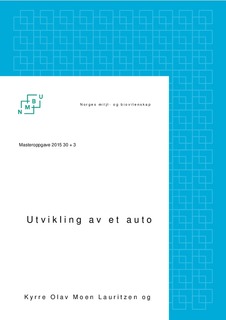| dc.contributor.author | Lauritzen, Kyrre Olav Moen | |
| dc.contributor.author | Ingebrigtsen, Pål Bjarni Knem | |
| dc.date.accessioned | 2015-07-08T11:35:50Z | |
| dc.date.available | 2015-07-08T11:35:50Z | |
| dc.date.copyright | 2015 | |
| dc.date.issued | 2015-07-08 | |
| dc.identifier.uri | http://hdl.handle.net/11250/292883 | |
| dc.description.abstract | Våren 2014 ble det av studenter ved NMBU utviklet og bygget en prototype av en autonom landbruksrobot. Målet var å utvikle en plattform for drift av utskiftbare
verktøymoduler for automatisering av repetitive oppgaver i landbruket. Denne rapporten er et utspring av dette prosjekt og omhandler utvikling og prototyping av et verktøy for autonom ugressbekjempelse tilpasset landbruksroboten.
Det er utført studier av økologisk landbruk for å avdekke utfordringer og løsninger innen ikke-kjemisk ugressbekjempelse. Resultater fra dette arbeidet er videre benyttet til å generere konsepter egnet til automatisk fjerning av ugress i grønnsaksåkre. Basert på konseptutredninger er løsning med størst antatt potensiale valgt for videre utvikling.
Bekjempelsesmetoder benyttet i valgt konsept er en kombinasjon av skrapepinner og høyintensive lasere med overordnet elektronisk styring for muliggjøring av autonom drift. Konseptet er videre utviklet og designet i SolidWorks og endelig produkt er klargjort for prototyping ved innkjøp av standardkomponenter og produksjon av egenutviklede komponenter.
Det er bygget en fungerende modulbasert prototype med mikrokontrollerbasert
drift tilpasset montering på autonom landbruksrobot. Verktøymodulen har 10 faste og 4 motoriserte skrapepinner for mekanisk arbeid, og én lasermodul med effekt på 3 W og med bølgelengde 445 nm. Laserstrålen kan fokuseres på en gitt koordinat i verktøyets avgrensede behandlingsområde. Verktøymodulen veier 13,1 kg, er 680 mm lang, 600 mm bred og 500 mm høy.
Det er utført testing av prototypens separate komponenter for å vurdere kompatibilitet med den autonome landbruksroboten. Ytterligere forsøk relevant for lasermodulens grad av bekjempelse ved ulik bestrålingsvinkel og dose er også gjennomført.
Det er funnet at landbruksroboten i kombinasjon med utviklet verktøy kan bidra
til å redusere bruk av plantevernmidler i jordbruk.
Prosjektet har ved analyse og forsøk med laserteknologi styrket troen på at termisk bekjempelse av ugress med laser har en posisjon i fremtidig
jordbruksteknologi.

During the spring of 2014 students at the Norwegian University of Life Sciences developed and build a prototype of an autonomously agricultural robot. The goal
of this work was to develop a platform for interchangeable tool modules that could automate repetitive agricultural tasks. This report is built upon previous work within that field and documents the development and prototyping of a tool for autonomously controlling growth of weeds.
There have been conducted studies of organic farming to reveal challenges and solutions in non-chemical weed control. The results from this work generated concepts suitable for automatic removal of weeds in vegetable fields. Based on concept studies the solution with the greatest estimated potential is selected for further development.
Methods of weeds control used in the selected concept is a combination of harrow tools and high-intensity lasers with electronic control enabling automatic
operation. The concept is developed and designed in SolidWorks and is made ready for prototyping by purchase of standard components and production of proprietary components.
It is built a functioning modular prototype adapted to the autonomously agricultural robot controlled with microcontroller technology. The module has 10 permanent and 4 motorized harrows for mechanical work, and one laser module with an output of 3 W and wavelength 445 nm. The laser beam can focus on a given coordinate in the modules limited treatment area. The module weighs 13,1 kg, is 680 mm long, 600 mm wide and 500 mm in height.
It is conducted testing of the prototype`s separate components to evaluate compatibility with the autonomous agricultural robot. Further experiments relevant for the laser module`s degree of controlling weeds at different irradiation angles and doses are also conducted.
It is found that the agricultural robot in combination with the developed tool can
help to reduce the use of pesticides in crops.
The project has by analysis and experiments with laser technology strengthened the belief that the thermal controlling of weeds with laser has a position in future
 | nb_NO |
| dc.language.iso | nob | nb_NO |
| dc.publisher | Norwegian University of Life Science, Ås | |
| dc.subject | Ugressbekjempelse | nb_NO |
| dc.subject | Autonome landbruksroboter | nb_NO |
| dc.title | Utvikling av et autonomt verktøy for ugressbekjempelse | nb_NO |
| dc.title.alternative | Development of an Autonomous Tool for Weed Control | nb_NO |
| dc.type | Master thesis | nb_NO |
| dc.subject.nsi | VDP::Technology: 500 | nb_NO |
| dc.subject.nsi | VDP::Technology: 500::Industrial and product design: 640 | nb_NO |
| dc.source.pagenumber | 106 | nb_NO |
| dc.description.localcode | M-MPP | nb_NO |
